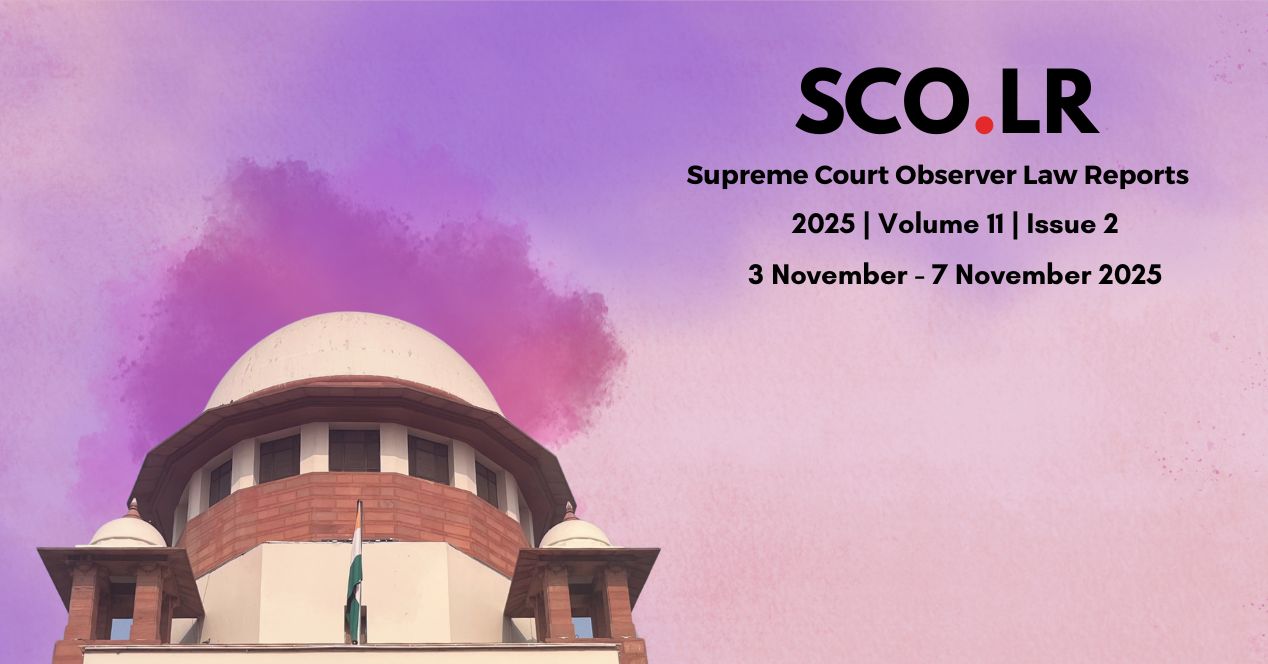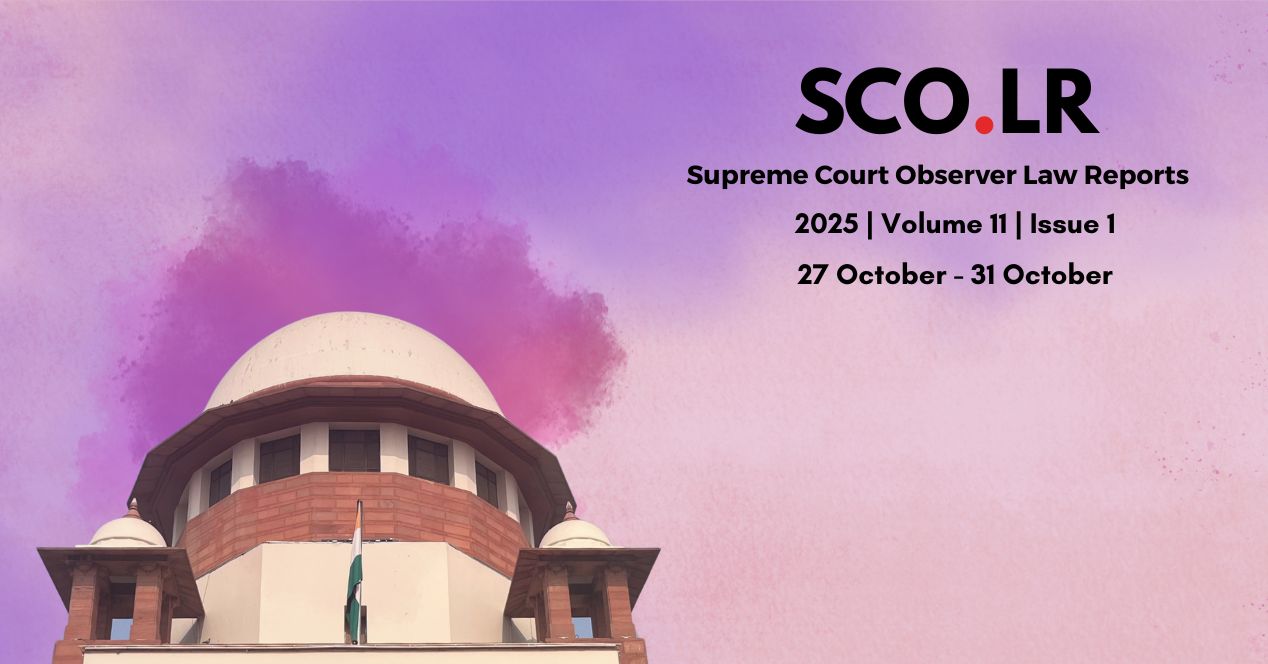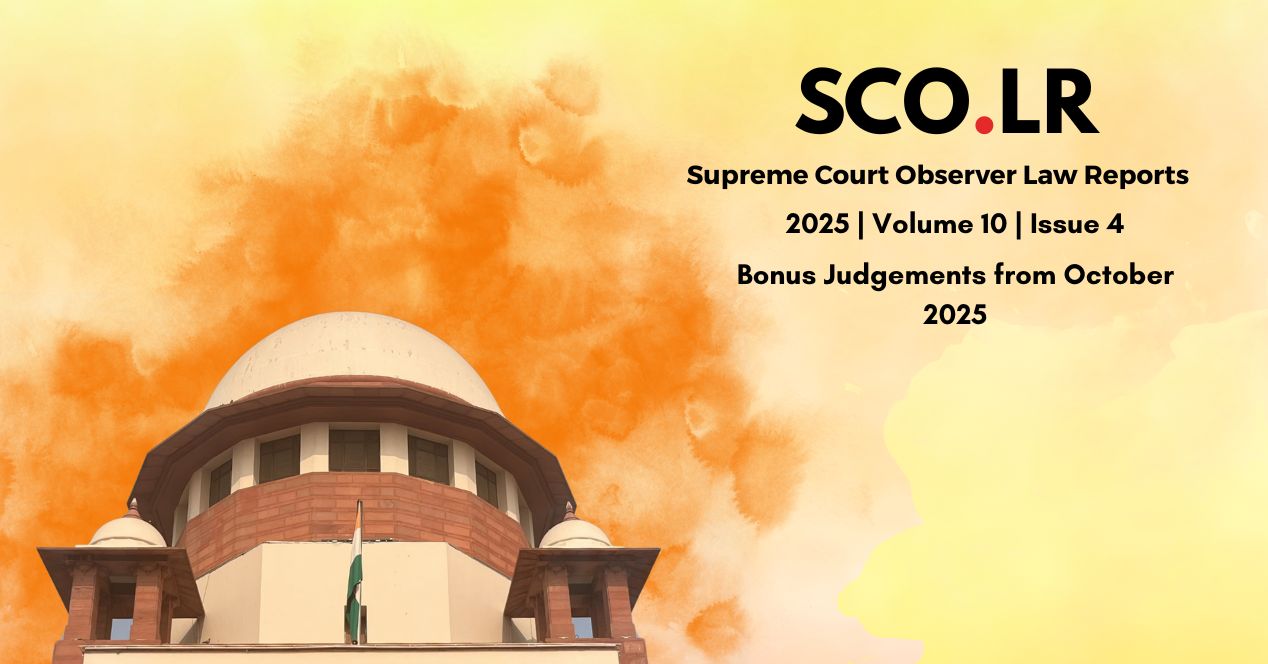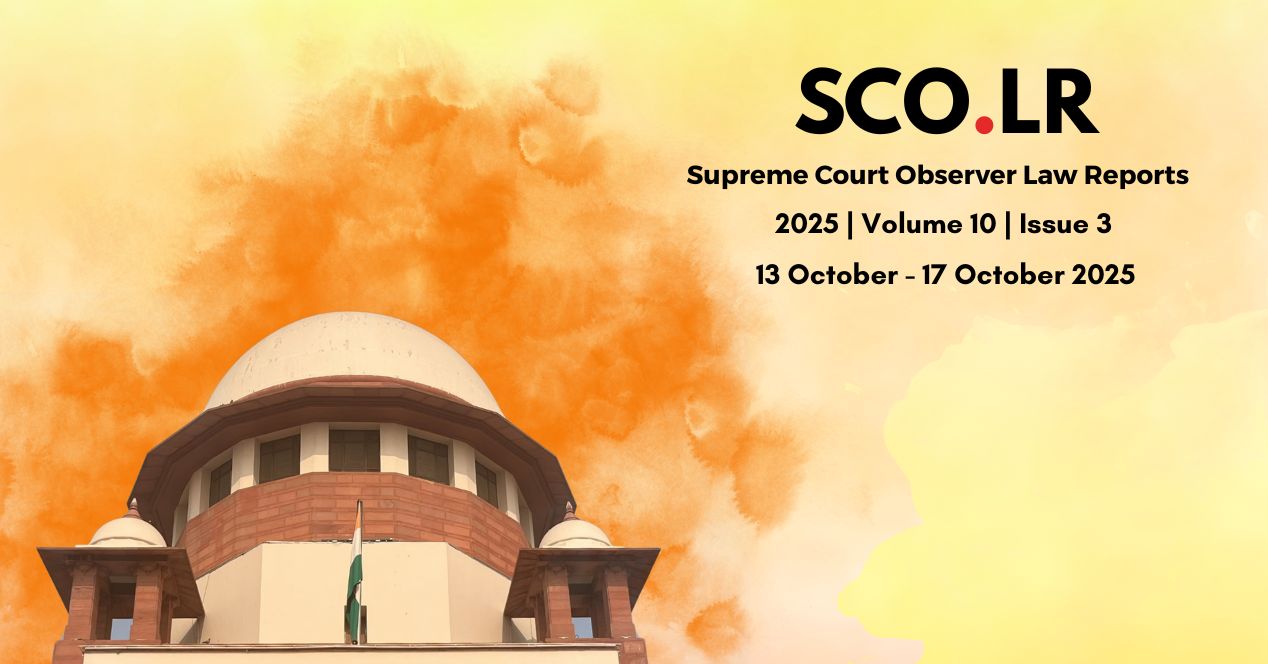Analysis
SCO.LR | 2025 | Volume 11 | Issue 3
In this Issue of SCO.LR, we bring you five important judgements from 10 November to 15 November 2025
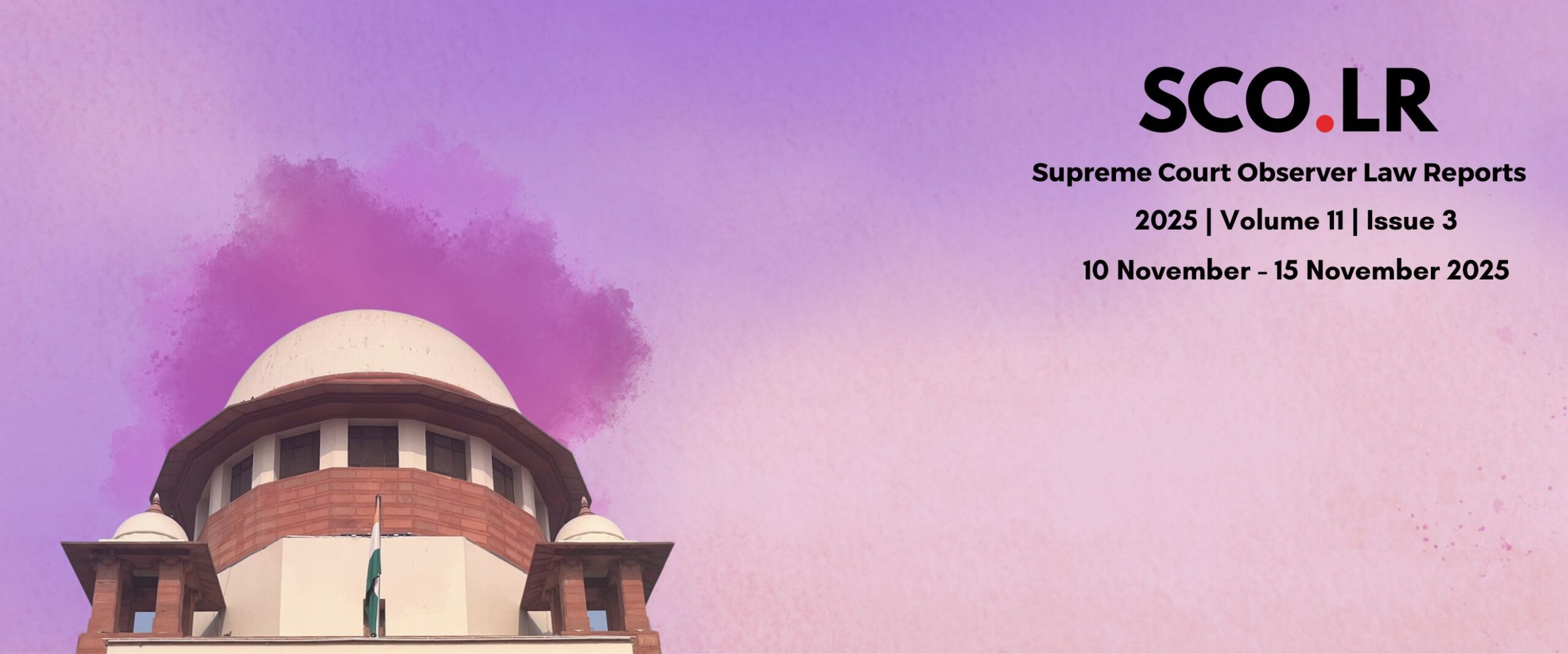
Volume 11 Issue 3 of the Supreme Court Observer Law Reports (SCO.LR) is here. In this edition, we summarise five key judgements of the top court from last week.
The cases in this issue cover the following subjects: exercise of curative power; declaration of forests as a sanctuary; the Consumer Protection Act; rent control; and enforcement of a decree.
As always, the SCO.LR home page has all judgements in a clean format which is easy to work with and cite. Our mindmaps will give you a quick snapshot of the facts, the arguments and the outcome.
**********
The Supreme Court Observer Law Reports
SCO.LR | Volume 11 | Issue 3
10 November – 15 November 2025
**********
Execution Without Clear Proof of Breach by Judgement Debtor
Kapadam Sangalappa v Kamapam Sangalappa
11 November 2025
Citations: 2025 INSC 1307 | 2025 SCO.LR 11(3)[11]
Bench: Justices P. K. Mishra and V. M. Pancholi
The Supreme Court held that an Executing Court cannot enforce a decree unless the decree-holder proves, through clear and convincing evidence, that the judgement debtor violated its terms.
The appeals arose from a long-standing dispute between two sections of the Kuruba community concerning rotation of idols, performance of rituals and management of their shared deity. These issues had been settled through a compromise decree in 1933. Decades later, however, the appellants alleged non-compliance and sought execution. The Executing Court allowed the petition but the High Court reversed it finding no evidence of violation, leading to the present appeal.
The Supreme Court dismissed the appeal. It held that in execution proceedings, the decree-holder bears the full burden of proving a clear breach. Execution cannot proceed on presumptions. The Court found no evidence of violation. It also found that certain preconditions for enforcement had been unmet, which had rendered execution legally unsustainable.
Key words/phrases: Execution proceedings—burden of proof—proof of violation—impermissible presumptions—compromise arrangement—failure to show breach—Executing Court
Read the Judgement here.
**********
Curative Power in Cases Involving Opposing Outcomes Based on Identical Evidence
Surendra Koli v State of Uttar Pradesh
11 November 2025
Citation: 2025 INSC 1308 | 2025 SCO.LR 11(3)[12]
Bench: Chief Justice B.R. Gavai, Justices Surya Kant and Vikram Nath
The Supreme Court held that it may exercise its curative powers to prevent arbitrary disparity of outcomes in separate cases relying on identical evidence. It found that allowing a conviction based on evidence that was rejected as inadmissible in identical cases violates Articles 14 and 21.
Surendra Koli was convicted for killing Rimpa Haldar. This was alleged to be one of the Nithari Murders in 2006. Koli’s conviction and death sentence, handed down by a Trial Court in 2009, was affirmed by the Allahabad High Court in 2009 and ultimately by a two-judge Bench of the Supreme Court in 2011. In 2014, the Supreme Court dismissed a review petition against the decision. Koli’s death sentence was later commuted to life imprisonment in 2015. In 12 other cases connected to the Nithari murders, however, Koli was acquitted by the High Court based on the same evidence. The Supreme Court had upheld these acquittals in July 2025. Koli filed a curative petition before the Supreme Court citing this judgement.
The Supreme Court noted that Koli’s conviction in the Rimpa Haldar case was based on confession and supposed discoveries. However, 12 other cases had held the evidence to be “legally unreliable”. As the two outcomes were irreconcilable, the Court found that conviction in the Haldar case would result in a grave miscarriage of justice.
Key words/phrases: Articles 14 & 21—arbitrary disparity—Rimpa Haldar murder—Surendra Koli—identical cases—Nithari murders—same evidence—curative petition filed—Supreme Court held evidence legally unreliable across cases—inconsistent outcomes violate fairness— miscarriage of justice
Read the Judgement here.
**********
Presumption of Wilful Default by Tenant
K. Subramaniam v Krishna Mills
11 November 2025
Citation: 2025 INSC 1309 | 2025 SCO.LR 11(3)[13]
Bench: Justices Dipankar Datta and Manmohan
The Supreme Court held that under Section 10(2)(i) of the Tamil Nadu Buildings (Lease and Rent Control) Act, 1960, a tenant’s default may be presumed to be wilful if it continues even after the landlord issues the statutory two-month notice contemplated in the Explanation. Where no such notice is given, the Rent Controller must independently determine whether the default was wilful.
The lessee had leased four portions of the respondent’s property between 1999 and 2001 for a total monthly rent of Rs. 48,000, though the lessee claimed it was Rs. 33,000. In 2004, the landlord initiated fair-rent proceedings, which culminated in the Rent Controller fixing the fair rent at Rs. 2,43,600 (later modified to Rs. 2,37,500). Despite these orders, and without obtaining any stay, the lessee continued to pay only the earlier contractual rent. The eviction petition filed in 2007 was initially dismissed but was allowed in appeal, and the High Court upheld the finding of wilful default.
The Supreme Court held that since the lessee never sought a stay of the fair-rent order and cleared arrears only years later, the default could not be treated as bona fide. Payments were made belatedly and only under court direction, amounting to wilful default. The Court affirmed the eviction order and reiterated that an appeal does not operate as a stay and tenants must comply with fair-rent orders unless expressly protected.
Key words/phrases: Wilful default—Fair rent fixation—Tamil Nadu Buildings (Lease and Rent Control) Act, 1960—Rent Control Appellate Authority—Absence of stay—Execution of decree—Two-month notice—eviction petition—Presumption of wilful default
Read the Judgment here.
**********
Declaration of Forest as Sanctuary
In Re: Saranda Wildlife Sanctuary
13 November 2025
Citation: 2025 INSC 1311 | 2025 SCO.LR 11(3)[14]
Bench: Chief Justice B.R. Gavai and Justice K.V. Chandran
The Supreme Court mandated the state government of Jharkhand to fulfil its constitutional and statutory duty of environmental protection and declare the Saranda forest as a wildlife sanctuary. This will bring the forest—the largest sal one in Asia—under the protection of the Wildlife Protection Act, 1972, (WPA).
Bihar had declared 31,468 hectares of the forest as the “Saranda Game Sanctuary” in 1968. After bifurcation, the land fell in Jharkhand’s territory. In 2022, in a case concerning overmining in the region, the Kolkata Bench of the National Green Tribunal (NGT) directed Jharkhand to consider declaring the land a sanctuary due to its ecological importance. The state said that it would notify 57,519 hectares as a sanctuary. In September 2025, the Supreme Court stated that Jharkhand had no reason to ignore the NGT’s direction. During the hearing, the state retracted the 57,519 hectares figure, stating they intended to notify only 24,941 hectares, as the remaining area comprises vital public infrastructure and homes of indigenous communities.
The Court held that Jharkhand had not provided justifiable reasons to exclude certain areas from the “conservation areas/no mining zones.” Moreover, the Court found the concern about indigenous communities unsubstantiated, as the WPA and Section 3 of the Forest Rights Act, 2006 protect the rights of forest dwellers even after an area becomes a sanctuary.
Key words/phrases: Section 18—declaration of a sanctuary—Wildlife Protection Act, 1972—Section 3, Forest Rights Act—Scheduled Tribes and other traditional forest dwellers—The Scheduled Tribes and other Traditional Forest Dwellers (Recognition Of Forest Rights) Act, 2006—Saranda Forest—mining in Jharkhand
Read the Judgement here.
**********
Commercial Use under the Consumer Protection Act
Poly Medicure v Brillio Technologies
13 November 2025
Citations: 2025 INSC 1314 | 2025 SCO.LR 11(3)[15]
Bench: Justices J.B. Pardiwala and Manoj Misra
The Supreme Court held that a company purchasing goods or services to streamline its business operations for efficiency and profit does so for a commercial purpose and is therefore not a consumer under Section 2(1)(d) of the Consumer Protection Act, 1986.
Poly Medicure Ltd, which imports and exports medical devices, purchased a software licence called Brillio Opti Suite for use in its documentation process. Claiming malfunction and deficiency of service, it filed a complaint before the Delhi State Consumer Commission. The complaint was dismissed as the company was not a consumer. The National Consumer Disputes Redressal Commission confirmed this decision.
The Supreme Court upheld the dismissal. The Court clarified that the statutory explanation relating to earning a livelihood by means of self-employment applies only to natural persons and cannot be invoked by corporate entities. It observed that the software purchase was directly connected to the company’s business operations and revenue generation, and therefore attracted the ‘commercial purposes’ exclusion
Key words/phrases: Consumer Protection Act 1986—Section 2(1)(d)—commercial purpose—corporate purchaser—software licence for business operations—consumer complaint not maintainable—connected to business operations—NCDRC upheld state consumer commission decision—Supreme Court upheld
Read the Judgement here.

